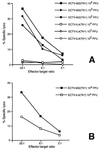Expression of mouse interleukin-4 by a recombinant ectromelia virus suppresses cytolytic lymphocyte responses and overcomes genetic resistance to mousepox
- PMID: 11152493
- PMCID: PMC114026
- DOI: 10.1128/JVI.75.3.1205-1210.2001
Expression of mouse interleukin-4 by a recombinant ectromelia virus suppresses cytolytic lymphocyte responses and overcomes genetic resistance to mousepox
Abstract
Genetic resistance to clinical mousepox (ectromelia virus) varies among inbred laboratory mice and is characterized by an effective natural killer (NK) response and the early onset of a strong CD8(+) cytotoxic T-lymphocyte (CTL) response in resistant mice. We have investigated the influence of virus-expressed mouse interleukin-4 (IL-4) on the cell-mediated response during infection. It was observed that expression of IL-4 by a thymidine kinase-positive ectromelia virus suppressed cytolytic responses of NK and CTL and the expression of gamma interferon by the latter. Genetically resistant mice infected with the IL-4-expressing virus developed symptoms of acute mousepox accompanied by high mortality, similar to the disease seen when genetically sensitive mice are infected with the virulent Moscow strain. Strikingly, infection of recently immunized genetically resistant mice with the virus expressing IL-4 also resulted in significant mortality due to fulminant mousepox. These data therefore suggest that virus-encoded IL-4 not only suppresses primary antiviral cell-mediated immune responses but also can inhibit the expression of immune memory responses.
Figures

References
-
- Andrew M E, Coupar B E H. Biological effects of recombinant vaccinia virus-expressed interleukin 4. Cytokine. 1992;4:281–286. - PubMed
-
- Bembridge G P, Lopez J A, Cook R, Melero J A, Taylor G. Recombinant vaccinia virus coexpressing the F protein of respiratory syncytial virus (RSV) and interleukin-4 (IL-4) does not inhibit the development of RSV-specific memory cytotoxic T lymphocytes, whereas priming is diminished in the presence of high levels of IL-2 or gamma interferon. J Virol. 1998;72:4080–4087. - PMC - PubMed
-
- Biron C A, Nguyen K B, Pien G C, Cousens L P, Salazar-Mather T P. Natural killer cells in antiviral defense: function and regulation by innate cytokines. Annu Rev Immunol. 1999;17:189–220. - PubMed
-
- Cheers C, Janas M, Ramsay A, Ramshaw I. Use of recombinant viruses to deliver cytokines influencing the course of experimental bacterial infection. Immunol Cell Biol. 1999;77:324–330. - PubMed
-
- Coupar B E H, Andrew M E, Boyle D B. A general method for the construction of recombinant vaccinia viruses expressing multiple foreign genes. Gene. 1988;68:1–10. - PubMed
Publication types
MeSH terms
Substances
LinkOut - more resources
Full Text Sources
Other Literature Sources
Research Materials

